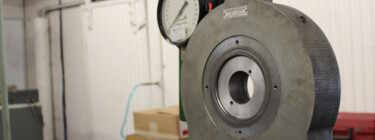The AISC Steel Construction Manual, 13th Edition has this to say about anchor rod nut installation.
“The majority of anchorage applications in buildings do not require special anchor rod nut installation procedures or pretension in the anchor rod. The anchor rod nuts should be “drawn down tight” as columns and bases are erected. This condition can be achieved by following the same practices as recommended for snug-tightened installation in steel-to-steel bolted joints in the RCSC Specification. That is, most anchor rod nuts can be installed using the full effort of an ironworker with an ordinary spud wrench.
When, in the judgment of the owner’s designated representative for design, the performance of the structure will be compromised by excessive elongation of the anchor rods under tensile loads, pretension may be required. Some examples of applications that may require pretension include structures that cantilever from concrete foundations, moment-resisting column bases with significant tensile forces in the anchor rods, or where load reversal might result in the progressive loosening of the nuts on the anchor rods.
When pretensioning of anchor rods is specified, care must be taken in the design of the column base and the embedment of the anchor rod. The shaft of the anchor rod must be free of bond to the encasing concrete so that the rod is free to elongate as it is pretensioned. Also, loss of pretension due to creep in the concrete must be taken into account. Although the design of pretensioned anchorage devices is beyond the scope of this manual, it should be noted that pretension should not be specified for anchorage devices that have not been properly designed and configured to be pretensioned.”
So, in a nutshell, what does this mean?
It means, that in normal circumstances, the normal effort of an ironworker with a regular spud wrench is sufficient to tighten the nuts on anchor bolts. In the event that special pretensioning is required, the design engineer should have carefully designed the anchor assembly specifically for that purpose and there should be detailed instructions so that the pretensioning is carried out properly.

It’s amazing how many times you are asked the same question and you give the same answer, which is what your article lead with… i.e. “most anchor rod nuts can be installed using the full effort of an ironworker with an ordinary spud wrench.” or “snug tight”. The first question regarding the necessary torque to shear off a 3/4 galvanized anchor, which I assume meant “how much is too much?” was about the best, but as you know, the number could be higher and it could be lower as you noted. I just read, then reread all of these questions and then your reasonable responses and just couldn’t refrain from throwing in my two cents. You guys are the best at what you do and please keep providing logical info like this for all of us. K
How much torque does it take to shear off a 3/4 galvanized anchor
@Thomas- It will depend on a number of factors; like coating, amount (if any) of rust, and the amount of lubrication (oil, wax, etc). Assuming this is a low carbon grade like F1554g36, the torque needed to bring the bolt to failure should be anywhere between 200-400 ft-lbs. If the nut gets cross threaded or galls, or if there is previous damage, the number could also be significantly lower.
Good morning, i have 3/4″ ASTM F1554 Grade 36 Anchor Bolts that are embedded in concrete for a Pump House at my job site and i would like to know if there is a required torque value for the said bolts ?
@Marthius- Per the AISC, anchor bolts are typically only torqued to snug tight. If the engineer requires anything other than that, they need to specify that.
In my reading of AISC, I observed that anchor bolts like A36/A307 are not mentioned clearly. I presumed to add more clear paragraphs and also tightening and even tables for anchor bolts and case to case basis.